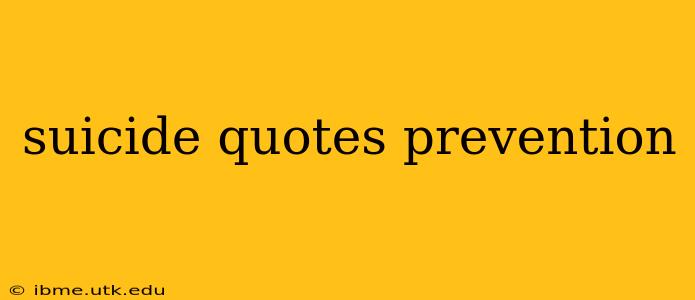Suicide is a complex and devastating issue, and the words used to describe or express suicidal thoughts can be equally complex and nuanced. While some quotes may appear to romanticize or glorify suicide, it's crucial to understand the underlying pain and desperation often expressed in such statements. This article explores the importance of responsible reporting on suicide-related quotes, while emphasizing the crucial role of prevention and support. We will also address some frequently asked questions surrounding suicide and its prevention.
What are some common themes found in quotes related to suicide?
Quotes associated with suicide often reveal a deep sense of hopelessness, despair, and isolation. They might express feelings of being overwhelmed, burdened by pain, or lacking a sense of purpose. These quotes aren't endorsements of suicide; rather, they reflect the intense emotional turmoil experienced by individuals struggling with suicidal thoughts. Understanding these underlying emotions is vital for effective prevention strategies. It's important to note that while these quotes may express intense feelings, they do not reflect the reality of suicide or suggest it as a viable solution.
Why is it important to approach suicide quotes responsibly?
Responsible reporting on suicide quotes is paramount. Sensationalizing or glorifying suicidal language can inadvertently normalize or encourage suicidal behavior, especially in vulnerable individuals. Context is crucial; quotes should be presented with sensitivity, emphasizing the underlying suffering and the importance of seeking help. Never isolate a quote without providing crucial context and resources for those struggling with similar feelings.
How can we prevent the spread of harmful messaging related to suicide?
Preventing the spread of harmful messaging requires a multi-pronged approach:
- Responsible Media Reporting: Media outlets should avoid sensationalizing suicide stories and focus on responsible reporting that highlights the availability of support and help. This includes avoiding graphic details that could be triggering.
- Educating the Public: Raising awareness about suicide prevention, the signs of suicidal ideation, and available resources is essential. This can be achieved through public health campaigns, educational programs, and community outreach initiatives.
- Promoting Mental Health Literacy: Improving mental health literacy empowers individuals to recognize and respond to signs of suicidal thoughts in themselves and others. This includes understanding the risk factors and protective factors associated with suicide.
- Online Safety: Social media platforms have a responsibility to implement effective content moderation policies that remove or flag harmful content related to suicide. This includes monitoring for glorification of suicide and promoting access to help.
How can I help someone who is talking about suicide?
If someone expresses suicidal thoughts, your immediate action is crucial. Listen empathetically without judgment, validating their feelings. Encourage them to seek professional help, and offer to help them find resources such as a crisis hotline or mental health professional. Never minimize their feelings, and assure them that help is available.
What are some resources available for people struggling with suicidal thoughts?
Numerous resources are available to provide support and guidance for individuals experiencing suicidal thoughts. These include:
- National Suicide Prevention Lifeline: (988) in the United States. This is a 24/7, confidential support line.
- Crisis Text Line: Text HOME to 741741 in the United States. This service provides confidential support via text message.
- The Trevor Project: Provides crisis intervention and suicide prevention services to LGBTQ young people.
- The Jed Foundation: Works to protect emotional health and prevent suicide for teens and young adults.
These resources offer immediate support and can help connect individuals with mental health professionals for ongoing care.
What are the warning signs of suicide?
Recognizing warning signs is crucial for intervention. These can include:
- Talking about suicide or death: Direct or indirect expressions of wanting to die or end their life.
- Expressing hopelessness or helplessness: Feeling overwhelmed, lacking purpose, or having lost interest in activities they once enjoyed.
- Increased risk-taking behavior: Engaging in reckless or impulsive activities.
- Changes in mood or behavior: Sudden shifts in mood, withdrawal from social activities, or changes in sleep patterns.
- Giving away prized possessions: Preparing for their death by distributing belongings.
Remember, if you suspect someone might be suicidal, reach out. Your intervention could save a life. The information provided here is for educational purposes and does not substitute professional mental health advice. Always seek help from qualified professionals for accurate assessment and treatment.
